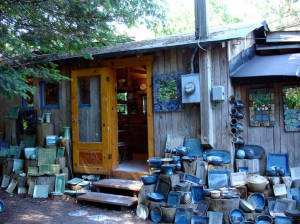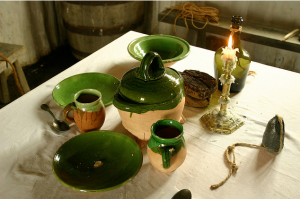HorseHair Pots
I first saw “horsehair p ots” in Colorado Springs, Colorado, and now wish I would have bought one. You also see them in New Mexico quite frequently. I was surprised that they really are made with horse hairs, giving them a marble-like appearance. At first, you might think these pots were made by Native Americans for 100s of years, but in fact, the process was created in the 1980s, when a long hair fell against the pot, leaving an interesting singe mark of burned carbon on the clay surface.
ots” in Colorado Springs, Colorado, and now wish I would have bought one. You also see them in New Mexico quite frequently. I was surprised that they really are made with horse hairs, giving them a marble-like appearance. At first, you might think these pots were made by Native Americans for 100s of years, but in fact, the process was created in the 1980s, when a long hair fell against the pot, leaving an interesting singe mark of burned carbon on the clay surface.
These horsehair pots range in height from 1 1/2″ (small one on front left) to 6 1/4″ (lidded jar in middle). The black ring around the top is actually a black raku glaze.
The horse hairs form the squigly lines on the white clay body. When the horse hair burns into the clay body, in some instances, the smoke from the burning raises and provides a smoke effect.
The pots shown here are from this studio: http://www.windblownstudio.com/horsehair.htm
1940s Italian Pottery Hand-Painted Luncheon Set
 Le Petite Poulailler writes: This sweet luncheon set was purchased from an antique shop in Illinois, back in the 1940s-50s ~ the name was Tippy’s; and yes, that was the lady’s name who owned the shop. She was the sweetest lady ~ my grandmother was an avid antiquer & would go to Tippy’s place at LEAST once a month and most times, I would tag along.
Le Petite Poulailler writes: This sweet luncheon set was purchased from an antique shop in Illinois, back in the 1940s-50s ~ the name was Tippy’s; and yes, that was the lady’s name who owned the shop. She was the sweetest lady ~ my grandmother was an avid antiquer & would go to Tippy’s place at LEAST once a month and most times, I would tag along.
I don’t remember Grandma purchasing this, but I have no doubt it is from a little antique shop in Southern Illinois called & Tippy’s.
Susan Crowe’s Pottery – Hornby, B.C.
 Hornby Island, British Columbia (Canada) sports its own funky mix of artisans and people who’ve retired from the rest of the world. Here you see the outdoor store of local artist Susan Crowe at Cannon Road Pottery.
Hornby Island, British Columbia (Canada) sports its own funky mix of artisans and people who’ve retired from the rest of the world. Here you see the outdoor store of local artist Susan Crowe at Cannon Road Pottery.
Most of her work seems to be in the blue color family. She doesn’t sell on the web, though. You’ll have to make an old fashioned visit to see her unique store.
Raquira Columbia (City of Pots)
 Ráquira, literally “City of Pots” in the Chibcha language, is a municipality and town in Boyacá Department, Colombia, part of the subregion of the Ricaurte Province.
Ráquira, literally “City of Pots” in the Chibcha language, is a municipality and town in Boyacá Department, Colombia, part of the subregion of the Ricaurte Province.
It is famous in Colombia for its colony of artisans, who produce traditional northern Andean pottery & hand-woven goods. The Sunday market is an especially popular time to visit.
Shang Dyanasty
If you are fortunate to find this in your attic, you might be quite wealthy. It’s a white pottery “Bu” with carved geometric pattern Shang Dynasty, 1600-1100 B.C.
White pottery with carved patterns, which appeared in the late Shang peroid, were made with a low content of ferric oxide (Fe2O3) and fired at temperature about 1000C. Mainly found in Shang dynasty tombs at Anyang, Henan, white pottery was exclusively used by the royal family, and very few pieces survived. The popularity of white pottery in Shang dynasty was closely related to the people’s preference for white among all colors.
In Shang dynasty, apart from white pottery, there are also pots of gray, red and black with imprinted patterns. The major utensils for every people are gray pottery, which has the largest production and is most abundant in archaeological sites.
The Palace Museum holds 340,000 pieces of ceramics and porcelain, including the imperial collections from the Tang Dynasty and the Song Dynasty, as well as pieces commissioned by the Palace, and, sometimes by the Emperor personally, thus represents the best of porcelain production in China.
The ceramic collection of the Palace Museum represents a comprehensive record of Chinese ceramic production over the past 8,000 years, as well as one of the largest such collections in the world.
Red Wing Stoneware (Minnesota)
 If you see a “Red Wing” emblem on your stoneware, chances are it is from “Red Wing Pottery” of Red Wing Minnesota. Red Wing Pottery production began in the mid 1860s. Craftsmen-potters from Germany settled in Red Wing, and using local natural resources, began producing pots.
If you see a “Red Wing” emblem on your stoneware, chances are it is from “Red Wing Pottery” of Red Wing Minnesota. Red Wing Pottery production began in the mid 1860s. Craftsmen-potters from Germany settled in Red Wing, and using local natural resources, began producing pots.
They produced ware for processing and storing food, such as crocks, jugs, and bowls, and other kitchen and farm items. They produced salt glaze pottery, characterized by a clay body of grey or tan with a surface that felt like the surface of an orange (pocked), and decorated with a simple hand-done, cobalt blue decoration of a bird or flower.
The factory is still in business today, so what you have may not be old. Check with a specialist if in doubt.
Green “Tea Cup” Pottery from Jeju Island, South Korea
 According to the photographer, who goes just by “lamoix”, this picture illustrates some lovely green and brown pottery at the otherwise disappointing International Tea Museum in Jeju.
According to the photographer, who goes just by “lamoix”, this picture illustrates some lovely green and brown pottery at the otherwise disappointing International Tea Museum in Jeju.
Jeju (also commonly known as Jeju-Do) on 1 July 2006, was made into the first and only special autonomous province of South Korea.
Making your Own Pottery
 Trey, who goes by “Pirana Snaps” took this photo of her first attempt at pottery. I’m impressed with what she did for a first timer, and love the blend of blue colors she used.
Trey, who goes by “Pirana Snaps” took this photo of her first attempt at pottery. I’m impressed with what she did for a first timer, and love the blend of blue colors she used.
Trey most like started by taking the clay, pugging it and wedging it on a pottery wheel. The first critical step is to get the clay centered properly, as all else depends on it. The next step is opening the centered clay so the her hands can begin to pull the clay up from both inside and out. This is basically where the rounded lump of clay gets its depth. At this point, the clay becomes a cylinder (even a plate is a very short, “squatty” cylindery). Water is added as needed to keep the clay moist.
Half-Glazed Fisherman’s Pottery from Nova Scotia
 According to Martin Cathrae, photographer, this is an example of the pottery a fishing family would have used. Note it’s only partially glazed, as I imagine fully glazing it would have cost more.
According to Martin Cathrae, photographer, this is an example of the pottery a fishing family would have used. Note it’s only partially glazed, as I imagine fully glazing it would have cost more.
The photo was taken in Nova Scotia, Canada, probably at the Fortress of Louisbourg National Historic Site.
